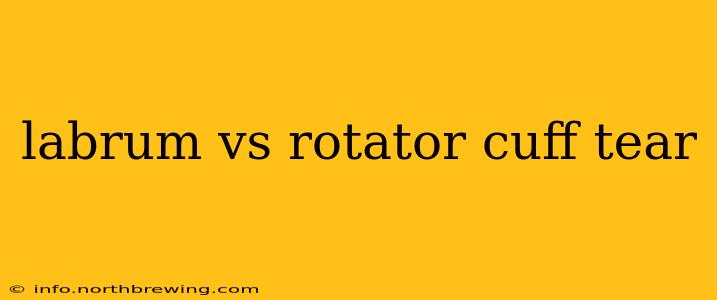Shoulder pain is a common ailment, often stemming from injuries to the labrum or rotator cuff. While both structures are crucial for shoulder stability and function, they are distinct and their injuries present differently. This article will clarify the key distinctions between a labral tear and a rotator cuff tear, helping you understand the symptoms, diagnosis, and treatment options.
What is a Labrum Tear?
The labrum is a ring of cartilage that surrounds the shoulder socket (glenoid). It acts like a gasket, deepening the socket and enhancing stability, allowing for a wider range of motion. A labral tear is a rupture in this cartilage, often caused by a sudden injury, repetitive overhead motions, or even gradual wear and tear. This can lead to significant shoulder pain, instability, and clicking or popping sensations.
Types of Labral Tears:
Several types of labral tears exist, classified by their location and appearance:
- SLAP (Superior Labrum Anterior to Posterior) tears: These affect the upper part of the labrum, commonly associated with overhead throwing activities.
- Bankart lesions: These occur in the front of the labrum, often associated with shoulder dislocations.
- Posterior labral tears: These occur in the back of the labrum.
What is a Rotator Cuff Tear?
The rotator cuff is a group of four muscles and their tendons that surround the shoulder joint. These muscles (supraspinatus, infraspinatus, teres minor, and subscapularis) help to control the shoulder's movement and stability. A rotator cuff tear occurs when one or more of these tendons are torn, often due to overuse, trauma, or age-related degeneration.
Types of Rotator Cuff Tears:
Rotator cuff tears can be classified by their size and location:
- Partial thickness tears: These affect only a portion of the tendon.
- Full thickness tears: These completely sever the tendon.
- Small, medium, or large tears: The size of the tear impacts the severity of symptoms and treatment options.
Labrum Tear Symptoms vs. Rotator Cuff Tear Symptoms
While both injuries can cause shoulder pain, the symptoms often differ:
Labrum Tear Symptoms:
- Pain: Often a deep, aching pain in the shoulder, possibly radiating down the arm.
- Instability: A feeling of the shoulder "giving way" or slipping out of place.
- Clicking or popping: Sounds or sensations during shoulder movements.
- Limited range of motion: Difficulty with certain movements.
Rotator Cuff Tear Symptoms:
- Pain: Pain in the shoulder, often worse at night or with overhead activities.
- Weakness: Difficulty lifting or rotating the arm.
- Limited range of motion: Reduced ability to lift or rotate the arm.
- Atrophy: Muscle wasting in the shoulder area (in more severe cases).
How are Labrum and Rotator Cuff Tears Diagnosed?
Diagnosis usually involves a physical exam, reviewing medical history, and imaging tests:
- Physical examination: The doctor assesses range of motion, strength, and stability. Specific tests can help pinpoint labral or rotator cuff problems.
- X-rays: Rule out fractures or other bone problems.
- MRI: Provides detailed images of soft tissues, allowing for clear visualization of labral and rotator cuff tears.
- Arthrogram: A specialized MRI that involves injecting contrast dye into the shoulder joint to better visualize the labrum.
Can You Have Both a Labrum and Rotator Cuff Tear?
Yes, it's possible to have both a labral tear and a rotator cuff tear simultaneously. Often, they can occur due to the same mechanism of injury. Accurate diagnosis is critical for appropriate treatment.
What is the Treatment for a Labrum Tear?
Treatment depends on the severity of the tear and the individual's activity level. Options include:
- Non-surgical treatment: Physical therapy, rest, ice, and medication.
- Surgical treatment: Arthroscopic surgery is often the preferred method for repairing labral tears.
What is the Treatment for a Rotator Cuff Tear?
Treatment options for rotator cuff tears also depend on severity and activity level:
- Non-surgical treatment: Physical therapy, rest, ice, anti-inflammatory medications, and sometimes cortisone injections.
- Surgical treatment: Surgery may be needed for significant tears that don't improve with conservative treatment. Arthroscopic or open surgery options exist.
How Long Does Recovery Take?
Recovery time varies significantly based on the type and severity of the injury, the chosen treatment method, and the individual's overall health and commitment to rehabilitation. It can range from several weeks for minor injuries to several months for more severe cases requiring surgery.
This information is for educational purposes only and should not be considered medical advice. Always consult a healthcare professional for accurate diagnosis and treatment of shoulder pain.
